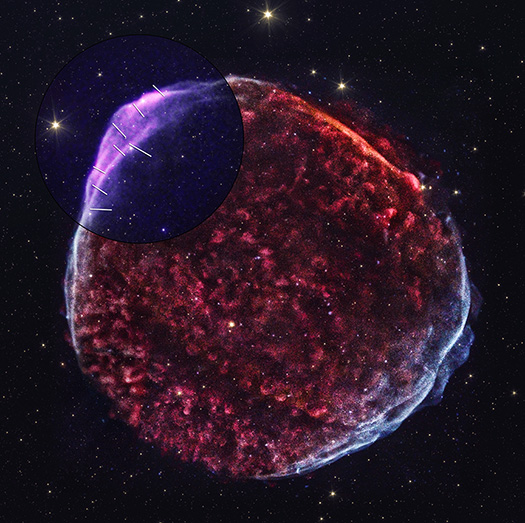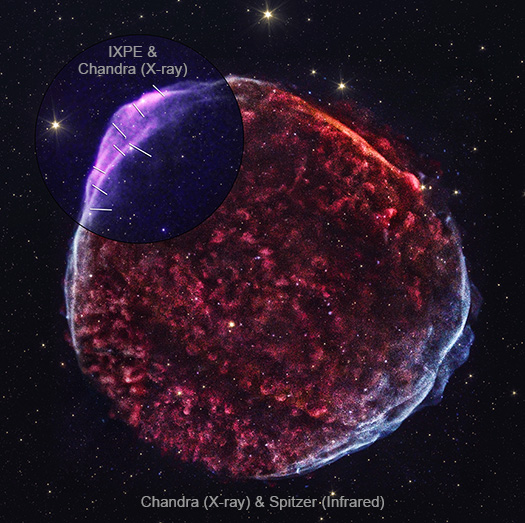IXPE and Chandra Untangle Theories Surrounding Historic Supernova Remnant

SN 1006 in X-ray and Optical Light
Credit: X-ray: NASA/CXC/SAO (Chandra); NASA/MSFC/Nanjing Univ./P. Zhou et al. (IXPE); IR: NASA/JPL/CalTech/Spitzer; Image Processing: NASA/CXC/SAO/J.Schmidt
When the object now called SN 1006 first appeared on May 1, 1006 A.D., it was far brighter than Venus and visible during the daytime for weeks. Astronomers in China, Japan, Europe, and the Arab world all documented this spectacular sight, which was later understood to have been a supernova. With the advent of the Space Age in the 1960s, scientists were able to launch instruments and detectors above Earth's atmosphere to observe the Universe in wavelengths that are blocked from the ground, including X-rays. The remains of SN 1006 was one of the faintest X-ray sources detected by the first generation of X-ray satellites.
This new image shows SN 1006 from two of NASA’s current X-ray telescopes, the Chandra X-ray Observatory and Imaging X-ray Polarimetry Explorer (IXPE). In the full image of SN 1006, red, green, and blue show low-, medium-, and high-energy detected by Chandra. The IXPE data, which measure the polarization of the X-ray light, have been added in the upper left corner of the remnant in purple. The lines in that corner represent the direction of the magnetic field.
Prior to this result, X-ray observations of SN 1006 offered important evidence that supernova remnants can radically accelerate electrons, making them a major source of highly-energetic cosmic rays detected on Earth. Chandra observations of SN 1006 previously suggested that the magnetic field in the sharp edges of the supernova remnant in the upper left and lower right is almost ten times stronger than surrounding regions. This enhances the acceleration of particles to high energies.

IXPE’s new findings helped validate and clarify theories that SN 1006’s unique structure is tied to the orientation of its magnetic field, and that the supernova blast waves correspond most closely with those field lines along its upper left and lower right edges, more efficiently sending high-energy particles streaming in those directions.
Researchers say the results demonstrate a connection between the magnetic fields and the remnant’s high-energy particle outflow. The magnetic fields in SN 1006’s shell are somewhat disorganized, per IXPE’s findings, yet still have a preferred orientation. As the shock wave from the original explosion goes through the surrounding gas, the magnetic fields become aligned with the shock wave’s motion. Charged particles are trapped by the magnetic fields around the original point of the supernova blast, where they quickly receive bursts of acceleration. Those speeding high-energy particles, in turn, transfer energy to keep the magnetic fields strong and turbulent.
A paper describing these results, publishing October 27, 2023 in The Astrophysical Journal, is available at https://arxiv.org/abs/2309.01879
IXPE is a collaboration between NASA and the Italian Space Agency with partners and science collaborators in 12 countries. IXPE is led by NASA’s Marshall Space Flight Center in Huntsville, Alabama. Ball Aerospace, headquartered in Broomfield, Colorado, manages spacecraft operations together with the University of Colorado's Laboratory for Atmospheric and Space Physics in Boulder.
NASA's Marshall Space Flight Center manages the Chandra program. The Smithsonian Astrophysical Observatory's Chandra X-ray Center controls science operations from Cambridge, Massachusetts, and flight operations from Burlington, Massachusetts.
Category:
- Log in to post comments
